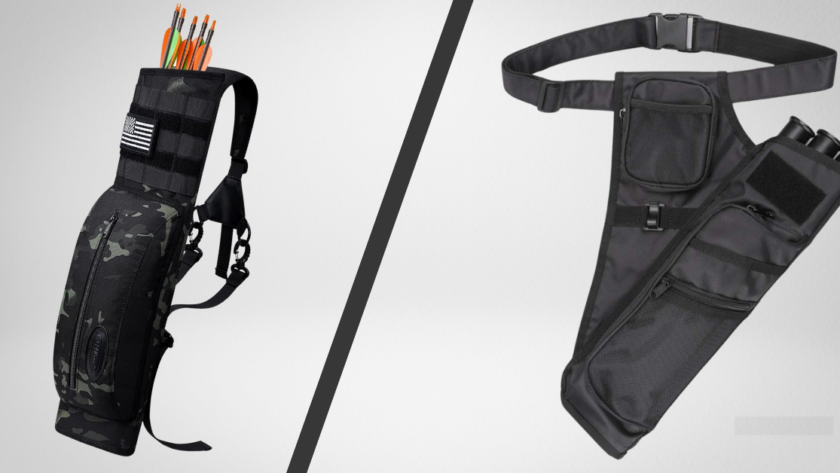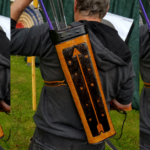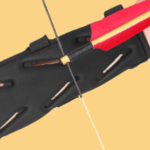The Historical Roots of Quiver Designs
Quivers have been an essential part of archery equipment for thousands of years. Back quivers, with their vertical design slung over the shoulder, have been depicted in ancient artwork from civilizations across the globe.
Egyptian hieroglyphs, Greek pottery, and Persian reliefs all showcase archers sporting these iconic arrow holders.
The image of Robin Hood with his back quiver has cemented this style in popular imagination.
Belt quivers, while perhaps less romanticized, have an equally rich history. Medieval European archers, particularly the feared English longbowmen, favored belt quivers for their practicality in battle.
The ability to quickly retrieve arrows from the hip proved invaluable in the heat of combat.
Native American tribes demonstrated remarkable adaptability in their quiver designs. Different regions and hunting needs led to variations in both back and belt quiver styles.
Some tribes crafted intricate quivers from animal hides, while others used woven plant fibers.
This diversity in historical quiver designs highlights a crucial point: the best quiver depends on the archer’s specific needs and environment.
Speed vs. Capacity: The Fundamental Trade-off
The most significant practical difference between belt and back quivers comes from the balance between arrow retrieval speed and overall capacity. Belt quivers excel in rapid arrow access.
Worn at the hip, they allow archers to grab arrows with minimal movement, often without taking their eyes off the target.
This speed advantage makes belt quivers a top choice for competitive archers and many hunters.
I vividly recall a hunting experience where this quick access proved crucial. As I crept through a dense forest, a deer suddenly appeared in a small clearing.
The ability to silently and swiftly nock an arrow from my belt quiver allowed me to take the shot before the animal could react.
In high-pressure situations, those split seconds can make all the difference.
Back quivers, while generally slower for arrow retrieval, offer greater capacity. This makes them well-suited for situations where a large number of arrows might be needed, such as extended hunting trips or traditional archery events.
However, this increased capacity comes with trade-offs in weight and potential noise.
Impact on Shooting Form and Balance
An often overlooked aspect of quiver choice is how it affects an archer’s balance and shooting form. Back quivers, especially when fully loaded, can significantly alter your center of gravity.
This shift can subtly impact your shooting stance and, so, your accuracy.
I learned this lesson the hard way during a grueling 3D archery competition. My back quiver, loaded with a dozen arrows, gradually affected my posture throughout the day.
By the final targets, fatigue had set in, and I noticed my shots consistently drifting as my form deteriorated because of the quiver’s weight.
Belt quivers generally have less impact on overall balance. The weight distribution closer to your body’s center allows for more consistent form over extended periods.
This stability is one reason why many target archers prefer belt quivers – they facilitate a more repeatable shooting process, crucial for maintaining accuracy over many shots.
Stealth Considerations for Hunters
For bowhunters, stealth is paramount. The noise generated by your equipment can alert game to your presence, potentially ruining a hunt before it even begins.
In this arena, belt quivers generally have an advantage.
Their close-to-body positioning minimizes arrow movement, reducing the chance of telltale rattles or clicks as you move through the woods.
Back quivers, with their more exposed design, are more prone to noise – especially when moving through dense underbrush. The vertical arrangement of arrows can lead to them clacking together with each step if not properly secured.
Beyond noise, the profile of your quiver can impact your ability to move stealthily. Back quivers can catch on branches or brush, potentially alerting game to your presence.
Belt quivers, being more compact, allow for easier movement in tight spaces.
This lower profile can be a significant advantage when stalking game or navigating through thick vegetation.
Customization and Versatility
Modern belt quivers offer impressive customization options. Many designs feature modular components, allowing archers to adjust capacity, arrow organization, and attachment methods to suit their specific needs. This flexibility is particularly valuable for archers who join in many disciplines or hunt various game types.
I’ve experimented with several custom setups, including a hybrid system that combines a small belt quiver for quick access with a detachable back quiver for additional capacity during longer hunts. This adaptability allows me to tailor my equipment to the specific demands of each archery outing.
Back quivers, while generally less customizable, have their own versatility advantages. Their design often accommodates a wider variety of arrow lengths and types.
This can be useful for archers who use different setups for various disciplines or game animals.
Traditional archers who enjoy crafting their own equipment often find back quivers offer more opportunities for personal artistic expression and historical authenticity.
Weather Resistance and Arrow Protection
Environmental factors play a crucial role in quiver selection, especially for outdoor archers. Back quivers, with their vertical orientation, can offer better protection from rain. Water tends to run off as opposed to pooling, potentially keeping arrows drier in wet conditions.
However, belt quivers often provide superior protection for arrow fletching. Arrows are typically stored fletching-up in belt quivers, reducing the risk of damage from moisture or contact with other surfaces.
This orientation also makes it easier to cover the arrows with a protective flap or hood in adverse weather.
During a particularly wet hunting season, I noticed that my arrows stored in a back quiver were more prone to moisture-related issues, especially those with natural feather fletching. Switching to a belt quiver with a good cover solved this problem, keeping my arrows dry and ready for action even in damp conditions.
The Aesthetic and Traditional Appeal
The visual and tactile aspects of archery equipment shouldn’t be underestimated. For many archers, especially those drawn to traditional styles, the look and feel of their gear is an integral part of the overall experience.
Back quivers undeniably possess a classic, romantic appeal. They evoke images of legendary archers and ancient traditions.
For reenactors or those passionate about historical accuracy, a well-crafted back quiver can be an essential part of their kit.
The sight of arrows peeking over your shoulder carries a certain mystique that many find irresistible.
Belt quivers, while perhaps less iconic, have their own aesthetic charm. Modern designs can be sleek and minimalist, appealing to archers who prefer a more contemporary look.
The choice between traditional leather and high-tech synthetic materials allows for further personalization.
Some archers appreciate the tactical, effective appearance of a well-designed belt quiver, seeing it as a reflection of their precise, methodical approach to the sport.
Adapting to Different Archery Disciplines
Your choice of quiver should be influenced by the specific archery discipline you practice. In Olympic-style target archery, belt quivers are almost universally preferred. The emphasis on rapid, consistent shooting makes the quick access and minimal interference with form provided by belt quivers invaluable.
Field archery and 3D archery present unique challenges that can influence quiver choice. These disciplines often involve varied terrain and shooting positions.
The lower profile of a belt quiver is less likely to snag on vegetation or interfere with awkward shooting angles.
However, the longer courses and higher arrow counts in these events might make the increased capacity of a back quiver appealing to some archers.
For traditional archery enthusiasts, particularly those who enjoy horseback archery, back quivers can be a natural fit. The ability to carry a large number of arrows without impeding movement on horseback is a significant advantage in this specialized discipline.
The historical authenticity of back quivers also appeals to many traditional archers who seek to connect with the roots of the sport.
Overcoming Common Quiver Challenges
Regardless of which style you choose, there are common challenges you’ll need to address to get the most out of your quiver:
Arrow Organization
Both quiver types benefit from internal dividers or arrow separators. These features prevent fletching damage and reduce noise by keeping arrows from rattling against each other.
Some high-end quivers offer adjustable dividers, allowing you to customize the fit for different arrow sizes or broadhead types.
Attachment and Detachment
Look for quivers with quick-release systems that allow for easy removal when not needed. This feature is particularly useful for transport or when settling into a tree stand for a long hunting session. Some archers prefer to remove their quiver before shooting to eliminate any potential interference with their bow’s balance.
Compatibility
Ensure your chosen quiver is compatible with your bow type and any additional accessories you use. Modern compound bows often have specific mounting points for quivers, while traditional bows may need different attachment methods.
Consider how your quiver will interact with stabilizers, sights, and other bow-mounted accessories.
Maintenance
Regular cleaning and care will extend the life of your quiver, regardless of style. Pay special attention to any moving parts or attachment points, as these are often the first to wear out.
Leather quivers may need occasional conditioning to maintain their suppleness and water resistance.
Exercises to Refine Your Quiver Technique
To truly master your chosen quiver style, dedicated practice is essential. Here are several exercises to help you refine your technique:
Timed Retrieval Drills
Set up a target and practice retrieving and nocking arrows as quickly as possible. Start with a relaxed stance, then time how long it takes you to nock an arrow and come to full draw.
Compare your times with different quiver styles to see which allows for the fastest, most consistent retrieval.
Blind Nocking
Practice retrieving and nocking arrows with your eyes closed or in low light conditions. This exercise helps develop muscle memory, allowing you to access your arrows smoothly and efficiently even when you can’t rely on visual cues.
Start slowly, focusing on smooth, deliberate movements, and gradually increase your speed as you become more comfortable.
Movement Drills
Set up an obstacle course and move through it quietly, paying attention to how your quiver affects your movement and noise levels. Include elements like ducking under branches, stepping over logs, and navigating through tight spaces.
This exercise is particularly valuable for hunters, as it simulates real-world conditions you might encounter in the field.
Endurance Practice
Spend extended periods wearing a fully loaded quiver to accustom yourself to the weight and balance changes. This is especially important if you’re transitioning from one quiver style to another.
Start with short sessions and gradually increase the duration.
Pay attention to how the quiver affects your posture and shooting form over time.
Rapid Fire Accuracy
Set up many targets and practice quickly acquiring and shooting at each one in succession. This drill combines quiver retrieval with target acquisition and accuracy.
It’s an excellent way to simulate high-pressure shooting situations and identify any weaknesses in your equipment setup or technique.
While Olympic recurve and compound target archery overwhelmingly favor belt quivers, other competitive disciplines show more variety in quiver selection.
Field archery competitions, which involve shooting at targets over varied terrain and distances, often see a mix of quiver styles. The choice often comes down to personal preference and the specific demands of the course.
Some archers prefer the quick access of a belt quiver for rapid shooting, while others opt for the higher capacity of a back quiver to carry extra arrows and equipment for the long courses.
3D archery, which simulates hunting scenarios with life-sized animal targets, presents unique challenges. The need for stealth and maneuverability in simulated hunting situations often leads competitors to choose compact belt quivers.
However, the unpredictable nature of 3D courses means that some archers prefer the extra capacity of a back quiver to confirm they have enough arrows for challenging shots or unexpected opportunities.
Traditional archery competitions often embrace a wider range of quiver styles, reflecting the diverse historical and cultural roots of the sport. Here, you’ll see everything from simple leather back quivers to elaborately decorated belt quivers, each chosen not just for functionality and for it’s aesthetic appeal and historical accuracy.
Quiver Innovation: Modern Materials and Designs
The archery industry continues to innovate, producing quivers that blend traditional designs with cutting-edge materials and manufacturing techniques. Modern belt quivers often feature lightweight, durable plastics and advanced fabrics that offer superior weather resistance and noise reduction.
Some incorporate carbon fiber components for unparalleled strength-to-weight ratios.
Back quivers have also seen significant advancements. New designs address traditional weaknesses like arrow rattle and weather exposure.
Some modern back quivers feature internal stabilization systems to keep arrows secure and silent, while others incorporate quick-detach mechanisms for easy removal in the field.
Hybrid designs are also gaining popularity, attempting to mix the best features of both styles. These might include belt quivers with extendable capacities or back quivers with hip-mounted quick-access sections.
While no single design can perfectly address every archer’s needs, these innovations offer exciting new options for those willing to experiment.
Environmental and Ethical Considerations
As awareness of environmental issues grows, many archers are considering the ecological impact of their equipment choices. Traditional quivers made from natural materials like leather and wood are biodegradable and often produced with less energy-intensive processes.
However, they may not be as durable as modern synthetic options, potentially leading to more frequent replacements.
Synthetic quivers, while often more durable and weather-resistant, raise concerns about long-term environmental impact. Some manufacturers are addressing these issues by using recycled materials or developing more eco-friendly production methods.
For hunters, ethical considerations extend to how quiver choice affects shot placement and recovery. A quiver that allows for quick, quiet arrow retrieval can contribute to more ethical hunting practices by enabling fast follow-up shots if needed. Additionally, a quiver that keeps broadheads securely covered reduces the risk of accidental injury to both the archer and any hunting companions.
Cultural Significance of Quiver Styles
Quiver styles often carry deep cultural significance, reflecting the archery traditions of different societies. Native American quivers, for example, were often elaborately decorated, serving as both functional tools and works of art that expressed tribal identity and individual status.
In many Asian archery traditions, the style and ornamentation of a quiver could show the archer’s rank or role. Samurai archers, for instance, used distinctive quivers that were an integral part of their combat gear and social identity.
European archery guilds often had specific quiver designs associated with different ranks within the organization. These served not just as equipment but as badges of achievement and belonging.
Understanding these cultural contexts can deepen an archer’s appreciation for the rich history of the sport and tell choices about equipment that go beyond mere functionality.
Psychological Aspects of Quiver Selection
The choice between a belt quiver and a back quiver can have subtle psychological effects on an archer’s performance. Some archers report feeling more “connected” to their arrows when using a belt quiver, with the close proximity providing a sense of readiness and control.
Others find the weight of a back quiver on their shoulders grounding, providing a comforting presence that enhances their focus.
In competitive settings, the quiver style an archer chooses can influence how they’re perceived by opponents and spectators. A sleek, modern belt quiver might project an image of efficiency and precision, while a traditional back quiver could evoke a sense of connection to archery’s ancient roots.
For hunters, quiver choice can affect confidence in the field. An archer who trusts their equipment to perform silently and efficiently is likely to move more assuredly and make better decisions under pressure.
Adapting Quiver Choice to Physical Limitations
Archers with physical limitations or injuries may find that their choice of quiver significantly impacts their ability to join in the sport. Belt quivers can be useful for people who have limited shoulder mobility, as they don’t need reaching over the shoulder to retrieve arrows.
Conversely, archers with hip or lower back issues might find a back quiver more comfortable, as it distributes weight more evenly across the upper body.
Some adaptive archery programs have developed specialized quiver designs to accommodate various disabilities. These might include quivers with extended handles for easier reach, or designs that can be operated with a single hand or even mouth controls.
The Future of Quiver Design
As archery continues to evolve, so too will quiver design. We’re likely to see increased integration of technology, such as quivers with built-in arrow counters or electronic systems to track arrow usage and inventory.
Smart materials that adapt to environmental conditions or user preferences could change how we think about arrow storage and retrieval.
3D printing and other advanced manufacturing techniques may lead to highly customized quivers tailored to individual archers’ bodies and shooting styles. This could blur the lines between traditional quiver categories, creating hybrid designs that offer the best of many worlds.
As archery spreads to new demographics and adapts to changing environmental and social conditions, quiver designs will likely continue to diversify. The challenge for manufacturers and archers alike will be balancing innovation with the rich traditions that make archery such a compelling and enduring sport.
People Also Asked
What is the best quiver for hunting?
The best hunting quiver depends on your specific needs and hunting style. Many hunters prefer belt quivers for their quick access and quiet operation.
However, back quivers can be useful for longer trips requiring more arrows.
How many arrows should a quiver hold?
Most quivers hold between 4-8 arrows, which is enough for most hunting and target archery situations. Competition archers may prefer quivers with higher capacities, while some minimalist hunters opt for smaller 3-arrow quivers.
Can you make your own archery quiver?
Yes, many archers enjoy crafting their own quivers. Traditional materials like leather and wood are popular for DIY projects.
Making your own quiver allows for finish customization to your needs and aesthetic preferences.
Are back quivers practical for hunting?
Back quivers can be practical for hunting, especially in open terrain or for longer excursions. However, they may present challenges in dense brush or when stealth is paramount.
Many experienced hunters find belt quivers more practical for most situations.
How do you attach a quiver to a recurve bow?
Most modern recurve bows have mounting points for attaching quivers directly to the bow. For traditional recurves without built-in mounts, strap-on quivers or separate hip quivers are common choices.
What’s the difference between a field quiver and a target quiver?
Field quivers are typically designed for outdoor use, with features like weather resistance and arrow separators. Target quivers are often simpler, focusing on quick access for competitive shooting.
Field quivers may also have additional pockets for accessories.
How do Olympic archers carry their arrows?
Olympic archers predominantly use belt quivers. These allow for rapid arrow retrieval and don’t interfere with the precise form required for competitive target archery.
Can you use a back quiver for target archery?
While less common, back quivers can be used for target archery. However, they’re generally slower for arrow retrieval and may affect an archer’s balance, making them less popular for competitive target shooting.
Key Takeaways
- Belt quivers offer faster arrow retrieval and less impact on shooting form, making them popular for competitive archery and many hunting scenarios.
- Back quivers provide greater arrow capacity and a traditional aesthetic, but can affect balance and generate more noise.
- Your choice should be influenced by your specific archery discipline, hunting style, and personal preferences.
- Both styles have historical precedent and modern innovations that can enhance their performance.
- Regular practice with your chosen quiver style is essential for developing efficiency and comfort in it’s use.



